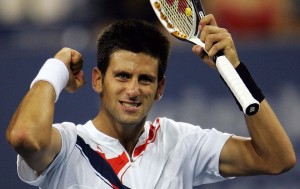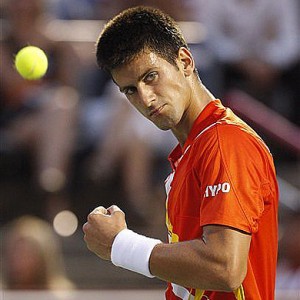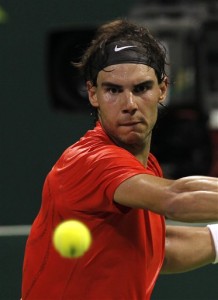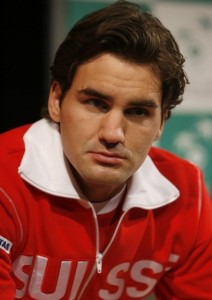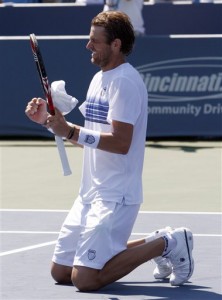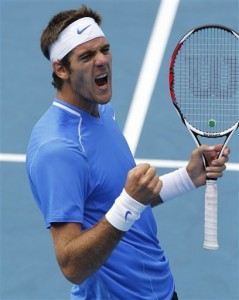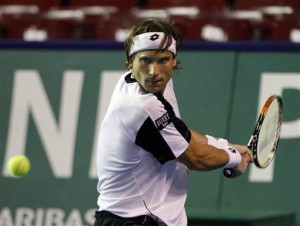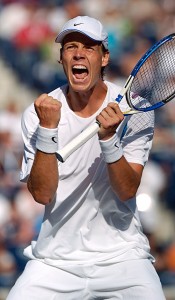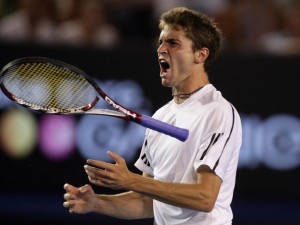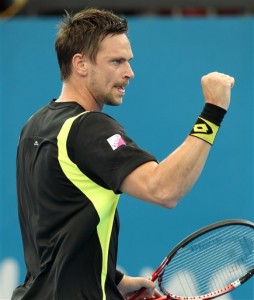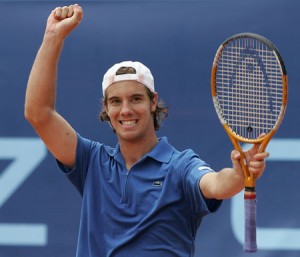Novak Djokovic Rules the Men’s Tennis Power Rankings After Dominating in Miami
The first three months of the tennis season pose some of the players’ biggest challenges.
With barely a fortnight to get their hard-court games into fine working order, the first Major of the year is upon them. Yet the Australian Open is just the beginning; ahead lie two months of hard-court rigor, all geared towards a second distant climax at the end of March.
Along the way are choices between indoor and outdoor, cool northern Europe and the hot Gulf states, even between hard courts and the points-rich Golden Swing on the clay of Latin America.
It is a topsy-turvy phase, where two of the most prestigious Masters events in the calendar close a season rather than building towards a concluding Major, and therefore, is often full of intrigue, unpredictable winners and surprising losers.
During the two months between Melbourne and Miami—where this edition of the Power Rankings is focused—there have been 10 different champions from 14 tournaments.
Kevin Anderson won his first tour title in Johannesburg, went on to reach the quarterfinals in the Miami Masters and now sits at an all-time ranking of 33.
Ivan Dodig won his maiden title in Zagreb and there was an even more significant first for the surging Milos Raonic, who started the year at 156 and now sits at 35. He announced his arrival big time by winning San Jose and then reaching the final of Memphis. Although he does not feature in this month’s rankings, he will surely join the party when the next hard-court season comes around.
One multiple winner, Nicolas Almagro, took titles in Brazil and Argentina and reached the final in Acapulco and, while he did not impress in the subsequent Masters, his form may impact on the clay road towards Roland Garros.
For each story of success, though, there has been one of ill fortune. Andy Roddick arrived in Miami on the back of his 30th career title in Memphis and with a 16-3 winning record for the year—and his record in Miami was second to none. But it soon became clear that Roddick was unwell during his opening match, and he made his earliest Miami exit since 2002. Now at No. 14 in the rankings, it is also his lowest position since 2002.
The biggest shock of this entire period, though, was the performance of Andy Murray, who replayed his post-Australian slump of 2010 with a vengeance.
Murray loves the North American Masters and was aiming to improve on last year’s quarterfinal finish in Indian Wells and his first-round exit in Miami. However, he lost in his first match at both as well as at the only other event he played, Rotterdam.
He is said to be reviewing his coaching setup ahead of the clay season and, with few points to defend before Wimbledon, that choice will have some time to bed in. One thing’s for sure: He needs to change something, and soon.
But while there have been surprises at almost every turn of the hard-court road that culminated in Miami, there has also been a clutch of constants. At every tournament they have played, Novak Djokovic, Rafael Nadal and Roger Federer have stayed the course at least as far as the semifinals.
One of them has been as constant as the North Star—the winner of every match in every tournament he has played since the start of the year and he, of course, tops the latest Power Rankings.
1. Novak Djokovic: Last Power Ranking: 1; ATP Ranking: 2
Last Four Tournaments: Miami (Winner), Indian Wells (Winner), Dubai (Winner), Australian Open (Winner)
Power Ranking Points: 1,617
From start to finish, the talk in Indian Wells was of Djokovic. He had continued his 2011 unbeaten run all the way to the title, dropping precious few games on the way, and he took the No. 2 ranking in the process.
He notched up his third victory over Federer on the trot—the semis in Australia and Indian Wells and the final in Dubai—and won his third tournament on the bounce. He even beat Nadal for the first time in six finals.
And the talk in Miami continued to be about Djokovic, from fund-raising football to an apparently seamless transition to more near-perfect tennis.
Since Serbia’s Davis Cup victory last December, his confidence has grown with every appearance. After sensibly withdrawn from Rotterdam to rest his shoulder, he made a strong statement in defeating Federer in Dubai: a 63 points to 44 points, 6-3, 6-3 win.
In taking his 21st title and sixth Masters in Indian Wells, he became only the third man on the tour to beat Nadal and Federer twice in a single tournament.
By Miami, his winning streak was truly jaw-dropping: 25 consecutive wins since December 2010, three consecutive titles and just five sets dropped from 62 played. In beating Nadal for two consecutive titles—both from a set down—he became the first since Federer to win the triple crown of the tennis season’s first swing: the Australian Open and these two prestigious Masters.
Djokovic continues to impress in so many ways. Not only is he supremely confident, but he is mentally agile in his tactical game plans and plays as well in defence as in attack—from serve to drop-shot, backhand slice to lob, baseline rally to volley.
Most important of all, though, he has become physically resilient, with no sign of the breathing or energy problems that dogged his former years. Anyone who can stand toe-to-toe with Nadal for more than three hours—and look the fresher man at the end—is an athlete of the first order.
As they switch to clay, though, the question on everyone’s lips will be: Can Djokovic beat Nadal for the first time on the red stuff? If he can, he will have that No. 1 ranking in his sights by the end of the year.
And one more thing: He is younger than every other player down to No. 20, so this man will be appearing in these Power Rankings a few more times yet.
2. Rafael Nadal: Last Power Ranking: 5; ATP Ranking: 1
Last Four Tournaments: Miami (Finals), Indian Wells (Finals), Australian Open (Quarterfinals), Doha (Semifinals)
Power Ranking Points: 844
Nadal’s post-Australian Open weeks were carbon copies of 2010. Last year, a knee injury forced him out of the tour after Melbourne but he returned to reach the semis in both Indian Wells and Miami. He then reeled off 22 straight wins to make a clean sweep of the clay swing and he still had enough petrol in the tank for Wimbledon.
This year, he had to work his way back to fitness after a Melbourne quarterfinal exit with a thigh tear. He knocked the rust off his game in Spain’s Davis Cup tie at the beginning of March and a week later he played in the fund-raiser, Clash of the Champions, with Federer.
The schedule worked a treat and a good draw in Indian Wells, playing three qualifiers in a row, worked him into even better form—which he needed in a surprisingly tough match against Ivo Karlovic in the quarters.
Nadal then beat a tired Juan Martin Del Potro in the semis and it looked as though he would beat Djokovic in their 24th meeting when he took the first set. But the Serb resisted and Nadal’s service went AWOL to concede the momentum and the title.
Miami produced another near-perfect semifinal lineup that reunited Nadal, Federer and Djokovic for the second consecutive tournament.
Nadal’s route this time was considerably tougher, but his form improved with every game he played as he took out Alexandr Dolgopolov, then Tomas Berdych and finally Federer in a blazing demonstration of tennis to reach his third Miami final and a chance for his first Floridian title.
Again, though, a first set advantage was wrestled back by Djokovic in a marathon of a match, and the exertions of his previous rounds started to appear in Nadal’s tired tactics and exhausted expression.
But it bodes well for Nadal that he is playing such strong tennis at this stage of the year. He is match-fit and heading for the haven of clay. He may have a stack of points to defend, but he also has a points buffer that should still find him at No. 1 as far ahead as Wimbledon.
If the Djokovic form continues through the clay, though, a few more wins from the Serbian could close that gap right up, but the progress of both may depend on the results of the third in the power struggle.
3. Roger Federer: Last Power Ranking: 3; ATP Ranking: 3
Last Four Tournaments: Miami (Semifinals), Indian Wells (Semifinals), Dubai (Finals), Australian Open (Semifinals)
Power Ranking Points: 602
It has not exactly been a bad season for Federer. Indeed, he’s been on a good run since the last time the tour hit the North American hard courts: five titles, including a Masters and the WTFs; two more Masters finals and a 500 final; and the semis of two Slams and three more Masters.
He came into Miami on a 22-3 winning run and without dropping a set in the tournament, but ahead lay the prospect of both Nadal and Djokovic. No matter that he had beaten both only four months ago in London. He had conceded all three of his 2011 losses to the latter and he was on the losing end of a 14-8 head-to-head rivalry with the former.
Federer’s very first meeting with Nadal was also in Miami when the 17-year-old Spaniard threw down the gauntlet with a straight-sets win, and the result was worryingly similar in 2011.
Not for the first time, Federer failed to absorb the aggressive pounding by Nadal to his high backhand wing and seemed unwilling to play the long game when he did get into rallies. His unforced error count—38 in a total of just 17 games—grew with each attempt to fire off an outright winner against a Nadal who never wavered.
So while Federer’s losses for the season may be few, he faces two daunting challenges in the No. 1 and No. 2 seeds.
He is fit, moving well and still keen to win, but Nadal and now Djokovic have his number. He will need to adopt the aggressive and varied tactics that he used to such good effect after joining forces with Paul Annacone if he is to avoid being dictated to on the clay.
He can pick up points in the coming months, but he will need them if he is to protect his ranking later in the year.
4. Mardy Fish: Last Power Ranking: NR; ATP Ranking: 11
Last Four Tournaments: Miami (Semifinals), Indian Wells (R64), Delray Beach (Semifinals), Memphis (Semifinals)
Power Ranking Points: 404
A year ago, the likeable Fish was floundering around the 100 mark in the rankings and on the verge of giving up the tour altogether. Instead, he picked himself up, dusted himself off and started—two stones lighter—all over again.
Once he hit the American hard courts in late summer, he was playing better than ever and rose inside the top 50, but he raised eyebrows when he claimed that his target was the top 10.
Wind forward to spring’s American hard courts and Fish is on the brink—at No. 11—of realising his ambition. And that is despite being hit last autumn by a hyperthyroid condition that caused him tiredness and muscle soreness.
His failure to beat the on-fire Djokovic in Miami in the semifinals was no disgrace, particularly in the light of the other scalps he did take: Richard Gasquet, Del Potro and David Ferrer.
Fish’s reward should soon be that top 10 place as he fits in more tournaments in the coming weeks—Houston, Rome and Dusseldorf—than he played last year. But he already has one new feather in his cap based on his hard-court success.
He is the U.S.’ top-ranked player for the first time in his career, having overtaken a Roddick also struggling with health problems. Not the best way to achieve a new high, but Fish is one man who has surely earned his moment in the spotlight.
5. Juan Martin Del Potro: Last Power Ranking: NR; ATP Ranking: 45
Last Four Tournaments: Miami (R16), Indian Wells (Semifinals), Delray Beach (Winner), Memphis (Semifinals)
Power Ranking Points: 277
It’s been a long, hard 12 months for Del Potro, but the last few weeks have broadcast the news in the clearest possible language: The 22-year-old from Argentina is back.
Not content with a gradual return to the tour after so long away with injury, he headed to North America straight after the Australian Open and got to the semifinals of San Jose.
The next week, it was Memphis and another semifinal. In his third consecutive week, he made his tournament debut in the Floridian heat of Delray Beach and won his first title of the year—indeed, his first title since the U.S. Open 18 months ago.
There was an immediate impact on his rankings. From a low of 484, making him a wild-card entry, he climbed to 90 by Indian Wells and lurked as an unseeded player at Miami as well.
In both Masters, he brought down a string of seeds: Dolgopolov, Ivan Ljubicic, Philipp Kohlschreiber and most impressively of all, Robin Soderling. Even against Nadal at Indian Wells, Del Potro got off to a great start, breaking in the opening game to lead 4-1 in the first set. But Nadal turned it on big time to pull back the set and the match, 6-4, 6-4.
Del Potro has played a lot of tennis in the past month and he looked very weary in his semifinal against Nadal. But he is steadily working back to his former fitness and should be pleased with his results and a further rise to inside the top 50.
With no points to defend for the whole year, he can continue the surge; it could be the work of just a few months to catapult him back inside the top 20. Once there, he will benefit from seeding and avoid the big names until deep into the draw.
Come the next North American swing in late summer, therefore, he may even be a contender for one of the next hard-court Masters.
6. David Ferrer: Last Power Ranking: 4; ATP Ranking: 6
Last Four Tournaments: Miami (Quarterfinals), Indian Wells (R64), Acapulco (Winner), Rotterdam (R32)
Power Ranking Points: 267
Ferrer is another man who was close to throwing in the towel at the beginning of last year and is another example of what hard work and determination can achieve.
His reward—at just turned 29 this week—is his highest ranking since October 2008 and becoming Spain’s No. 2 player.
Unlike last year, Ferrer played only one clay event this spring—winning in Acapulco—after making a surprise first-round exit in Rotterdam. The clay venture seemed to affect his return to the hard courts as well, with an opening-round loss at Indian Wells, but he bounced back with a good run to the Miami quarterfinals. Indeed, he dropped only 12 games in three matches before running into Fish.
He still has enviable stats for the year: 17 wins to four losses. He has begun to attack the net with more confidence and is—against the odds—playing almost as well on hard courts as his favored clay. These are skills and tactics that may add an extra facet when he opens his European clay account, and he will need them.
Last year, he stacked up three semis and one final finish in four consecutive tournaments, and that will take some defending.
7. Tomas Berdych: Last Power Ranking: NR; ATP Ranking: 7
Last Four Tournaments: Miami (Quarterfinals), Indian Wells (R16), Dubai (Semifinals), Marseille (Quarterfinals)
Power Ranking Points: 246
It was this time last year that Berdych made his surge from 25 to No. 8 by July and he has not dropped below that level since.
After a poor run at the end of 2010, the big Czech started to post some more good results in 2011 and his first-round demolition in Rotterdam of Guillermo Garcia-Lopez—dropping just six points on serve—was outstanding. His run there was brought to an abrupt halt by a dose of flu.
Berdych then reached the quarters in Marseille and looked as though he would upset Djokovic in Dubai when he took the first set. But at 5-2 down in the second, he required the trainer for a thigh injury and was forced to call it a day halfway through the final set.
He returned well in the American Masters, taking the first set against a bullish Stan Wawrinka in Indian Wells and doing the same against Nadal in Miami. Berdych fired 11 aces at Nadal in what was the Spaniard’s tightest match until the final, but the pleasing factor in the Berdych game has been his improved movement and willingness to approach the net.
This added dimension may help the tall Czech make more inroads on the men above him, if not on the clay then surely in pursuing another strong run at Wimbledon and, beyond that, when the hard courts come around again.
8. Gilles Simon: Last Power Ranking: OLI; ATP Ranking: 23
Last Four Tournaments: Miami (Quarterfinals), Indian Wells (R32), Dubai (Quarterfinals), Marseille (R16)
Power Ranking Points: 213
Simon wrestled for months with a knee injury last year but has gradually returned to form. He opened the year by winning the Sydney title without dropping a set and went on to give Federer an almighty run for his money in the Australian Open.
His work since then had been mixed, comprising long matches that were ultimately lost in Rotterdam, Marseille and—in particular—against fellow Frenchman Gasquet in Dubai and then Jurgen Melzer in a five-set Davis Cup tie.
But with Miami came some better results—also in long three-setters that brought him face-to-face with Federer again. This time, he retired with a sore neck after three games, but his progress has been enough for him to continue his rise from outside the top 40 at the start of the year to 23 this week.
He did not play the clay season at all last year so he could put on plenty more points before the grass season. Whatever the surface, though, his difficult and resilient return game will not be a welcome sight in the early rounds for any of the leading men.
9. Robin Soderling: Last Power Ranking: 9; ATP Ranking: 5
Last Four Tournaments: Miami (R32), Indian Wells (R32), Marseille (Winner), Rotterdam (Winner)
Power Ranking Points: 158
Just when Soderling looks as though he is about to take all before him on the tour, he seems to hit the buffers—and that is the story of his hard-court swing.
He started with a bang—an opening title in Brisbane—and lost a long and close battle against Dolgopolov in Melbourne. From there, it was the Rotterdam title back-to-back with the Marseille title and a tie-winning rubber in the Davis Cup.
So he went to North America, where he reached the semis at both Indian Wells and Miami last year on a 17-1 win-loss record.
He had not, though, banked on Kohlschreiber playing his artistic brand of destructive tennis in Indian Wells, nor on having a foot injury; and he had already pulled out of the doubles competition with illness.
In Miami, it was Soderling’s misfortune to draw Del Potro in his second match and, on the back of an arduous battle in his first round, the Swede could not respond to the Argentine’s power.
He has a heavy schedule lined up for the clay—four tournaments plus Roland Garros, where he made such an impact last year—so it looks as though he is determined to pull back the No. 4 ranking that he lost to Murray this week, despite the Scot having worse runs than Soderling at every turn since Melbourne.
That really must add insult to injury.
10. Richard Gasquet: Last Power Ranking: NR; ATP Ranking: 18
Last Four Tournaments: Miami (R32), Indian Wells (Quarterfinals), Dubai (Semifinals), Zagreb (Quarterfinals)
Power Ranking Points: 140
Gasquet is yet another player clawing his way back into contention on the tour after sliding to No. 82 less than a year ago. It’s three years since he was a top-10 player and he is arguably still a long way off the form he showed then.
Nevertheless, with a new coaching team in his corner, there have been flashes of the kind of tennis that marked him as the teenager to watch back in 2007. In Indian Wells, he beat two top-10 players back-to-back: Roddick and Jurgen Melzer.
He then took more games off Djokovic than the Serb’s three preceding opponents put together. Indeed, Gasquet took a 2-0 lead in the first set against Djokovic but the third game—all 13 minutes and seven deuces of it—was pivotal. Djokovic got the break back and stormed through six-straight games for the set, and subsequently the match.
What the Frenchman should learn from that lesson, though, is that his aggressive, net-attacking game drew far more rewards from Djokovic than retreating to the baseline, which is where he spent most of the second set.
Gasquet has the talent. He now needs the confidence to use it, as Djokovic has done.
The Tennis Power Rankings series is produced by Marianne Bevis, JA Allen and Feng Rong who does all the mathematics.
